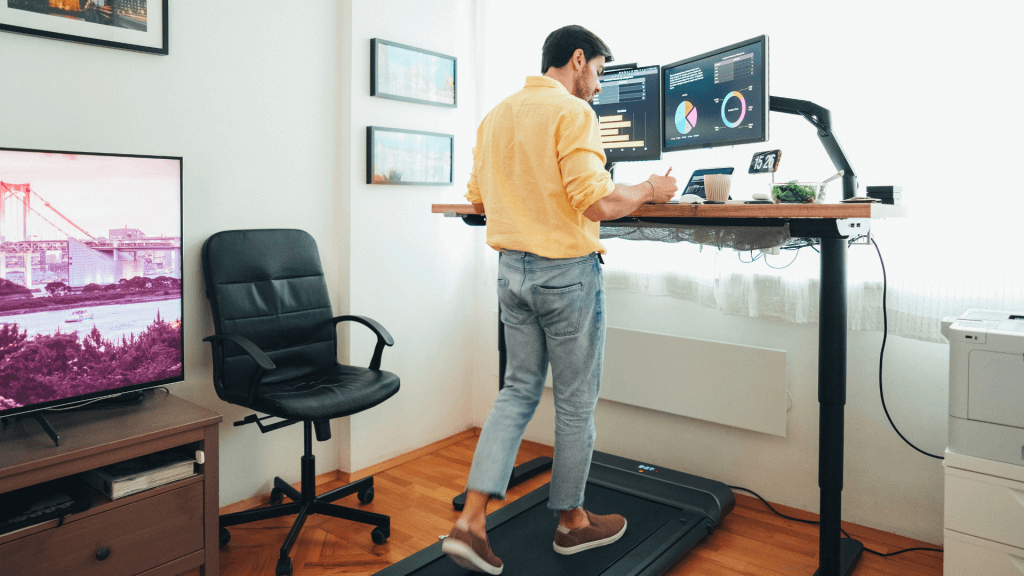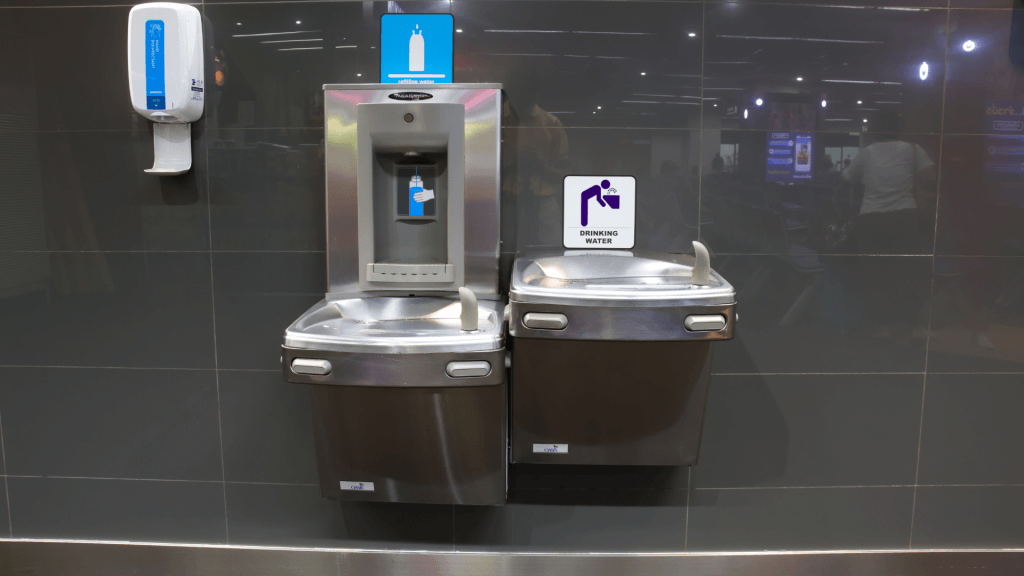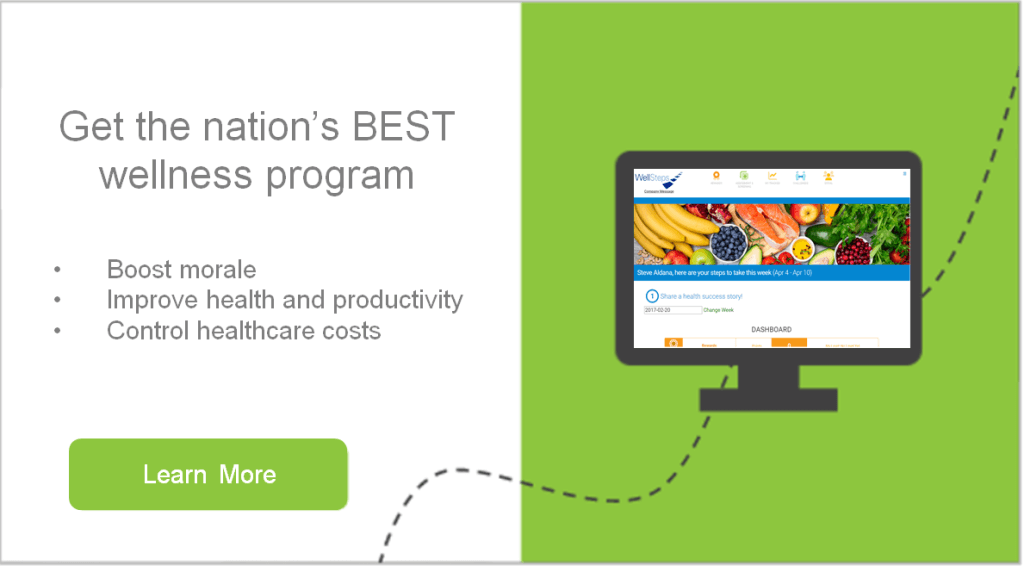In today’s fast-paced and demanding work environments, employers are increasingly recognizing the importance of employee well-being. A healthy workforce not only leads to increased productivity but also supports a positive work culture and reduces absenteeism. One of the most effective ways to support well-being is by providing a range of health tools for employees.

Today we’ll explore why investing in these resources is a win-win for both employers and their teams. When it comes to creating a workplace that prioritizes health and wellness, the right tools can make all the difference.
Health Tools For Employees Needed In Workspaces
Take a moment to think about these important elements. They have the potential to turn your workplace into a healthier and happier environment in very simple ways.
- Standing Desks: Encourage a more active workday by offering adjustable standing desks that combat the negative effects of prolonged sitting.
- Walking Pads: Keep your people moving even during desk-bound tasks with walking pads that fit nicely under desks.
- Anti-Fatigue Mats: For those that are on their feet almost too much during a work shift, give them stress relief mats to stand on when not moving to avoid strain as well.
- Water Stations: Install water stations so that everyone can stay hydrated easily if they forget their own water bottles.
- Healthy Food Options: Stock your office kitchen or cafeteria with nutritious snacks and meals. Providing the meals free, if possible, to ensure they eat well provides an added boost.
- Maps for Walking Routes: Encourage breaks by providing maps of nearby walking routes, or paths through your buildings. Outdoor is better, but indoor is great if that’s not always an option.
- Shared Workout Equipment: Create a mini fitness center at the workplace, equipped with things like dumbbells, yoga mats, exercise balls, etc. Employees can relax and recharge when needed, even lay down and nap for short periods of time.
- Meditation Rooms & Rest Spaces: Support mental health with dedicated meditation rooms where employees can find peace and quiet to clear their heads.
- Health Day Calendars: Keep your team engaged and informed with calendars highlighting health-related events, workshops, and activities.
- Wearables: Provide the benefits of wearables that track fitness metrics that can be used alongside your wellness programs for individual health benefits.
By providing these health tools for employees, you’ll be taking a proactive step toward enhancing their well-being and increasing the wellness benefits for your company as a whole. Today we’ll talk about the many benefits of incorporating these tools into your workplace, ranging from improved employee morale to increased productivity.
RELATED: 10 Ways to Promote Health and Wellness Topics at Work
Elevate Your Office Experience With Standing Desks
Prolonged sitting has been proven to wreak havoc on our health. It’s associated with a host of negative effects, including increased risk of obesity, heart disease, and type 2 diabetes. When we sit for extended periods, our metabolism slows down, leading to weight gain and heightened risk of chronic conditions. It can cause poor posture, leading to back and neck pain. Muscles weaken, blood circulation slows, and there’s a notable drop in energy levels, affecting overall productivity.

To combat these detrimental consequences, incorporating regular movement and ergonomic solutions like standing desks into our daily routines is crucial for preserving our employees’ physical and mental well-being.
RELATED: Lifestyle Medicine Programs At Work For Chronic Disease Prevention
The Benefits of Providing Adjustable Standing Desks to Office Employees
In the past, and as an unfortunate standard practice still, employees have been required to provide a doctor’s report or approved request in order to “qualify” for a standard desk option. This should never be necessary. Offering adjustable standing desks should be a standard benefit and here are compelling reasons why.
1. Improved Strength and Posture: Standing desks encourage better posture, reducing the risk of musculoskeletal issues like back and neck pain, headaches, even eye strain. This also causes muscular strength to increase, reducing pain, and supporting better neurological health.
2. Enhanced Focus and Productivity: Have you ever dosed off while sitting in front of the computer? Yeah, standing desks boost alertness and energy levels. Employees find it easier to concentrate on tasks, resulting in more effective and efficient work quality.
3. Customizable Comfort: Employees can easily switch between sitting and standing, tailoring their workspace to their comfort level and needs throughout the day. Customizable health tools for employees are more likely to get used.
4. Reduced Health Reporting Hassles: Providing standing desks as a standard benefit eliminates the need for employees to undergo the cumbersome process of filing health reports with doctors to justify their need.
5. Attracting and Retaining Talent: Offering standing desks demonstrates your commitment to employee well-being, making your company more attractive to potential hires. It helps retain existing talent leading to higher morale and reduced turnover rates.
Adjustable standing desks are more than just a trendy office accessory; they’re a practical and beneficial tool for any workspace. By providing these desks as a standard benefit, it’s a win-win investment that can yield long-lasting positive results.
RELATED: The Correlation Between Wellness Programs and Increasing Productivity in the Workplace
Advantages of Walking Pads for Stationary Employees
For employees who are required to stand in a single location during their work hours, the introduction of walking pads can be a game-changer. These can also be put right under standing desks or work benches. The regular movement of walking, even slightly, has incredible benefits.

1. Enhanced Physical Health: Walking pads allow employees to engage in low-impact activity which prevents muscle fatigue and joint pain, increases blood flow and strengthens weight bearing connections.
2. Improved Blood Circulation: Increase in blood flow promotes better blood circulation, reducing the risk of blood pooling in the lower extremities and swelling or low blood pressure.
3. Increased Productivity: Employees will gain the benefits of increased energy from the movement which boosts focus and productivity on work tasks.
4. Mental Well-being: Walking promotes the release of endorphins, which reduces stress levels and enhances mood and positivity for employees at work.
By incorporating walking pads into the workplace, employers not only enhance the physical well-being of their employees but also support an environment that values health, productivity, and overall job satisfaction.
RELATED: Workplace Health Models: Your Secret to Happy, Engaged Teams
Classic of Health Tools For Employees: Anti-Fatigue Mats for Employees on Their Feet
For employees who spend long hours on their feet, the introduction of anti-fatigue mats can significantly improve their work experience and overall well-being when walking pads aren’t an option. These mats offer a range of benefits that contribute to physical comfort, health, and productivity as well, such as:
1. Enhanced Comfort: Anti-fatigue mats provide cushion and support that reduces the strain on feet, knees and hips. This allows your employees to stay comfortable for longer periods of time.
2. Reduced Fatigue and Pain: By reducing the negative impacts on joints and muscles, employees have less fatigue and discomfort. Long-term strain resulting in muscular-skeletal wear and tear is minimized.
3. Increased Productivity: Comfortable employees can focus on their work and stay alert longer, improving work performance and levels of efficiency.
4. Safety Enhancement: Anti-fatigue mats have other safety benefits helping create non-slip surfaces, reducing slips and falls in areas with water surfaces.
5. Ergonomic Support: After reducing fatigue and muscle soreness, there is added ergonomic support on the back and posture of users. This helps reduce the risk of even more work-related injuries.
Incorporating anti-fatigue mats into the workplace not only prioritizes the physical comfort and health of employees but also contributes to a more positive and productive work environment. These mats are a valuable investment in the overall well-being of your workforce, let alone are fairly inexpensive.
RELATED: 19 Healthy Work Environment Examples to Upgrade Your Employees’ Physical Well-Being
Why You Should Provide Water Stations At Work
Providing water stations in the workplace offers numerous advantages. It promotes employee hydration and overall health, enhancing cognitive function and thinking. Additionally, it contributes to cost-efficiency by reducing single-use plastic bottle consumption.

Water stations encourage healthier beverage choices, aligning with wellness goals, and promoting sustainability by reducing waste. Ultimately, this small yet impactful investment leads to a healthier, more productive, and environmentally conscious workplace.
RELATED: 5 Unique Ways to Help Employees Drink More Water
Fresh Ideas for Providing Healthy Food and Snack Options to Employees
The healthy benefits of eating well and great work performance is clearly linked. Creating accessible and appealing options for healthy food and snacks is essential for promoting employee well-being and productivity, regardless of the work setting.
Here are unique ideas tailored for both traditional office settings with cafeterias and remote or on-the-road workers. No matter what kind of work environment your employees are in, there are ways to support better nutrition for their health.
For Traditional Office or Location Settings
- Healthy Cafeteria Overhaul: Revamp the cafeteria menu to include a variety of nutritious, customizable options like build-your-own salads, whole grain sandwiches, and low-fat soups.
- Nutrition Workshops: Host regular workshops or cooking demonstrations at your organizations building space, educating employees on preparing healthy meals and snacks at home.
- Snack Stations: Set up self-serve snack stations with fresh fruits, veggies, yogurt, and nuts, allowing employees to grab nutritious snacks throughout the day. Remember those with allergies or dietary needs.
- Farm-to-Table Partnerships: Collaborate with local farmers or vendors to provide fresh, seasonal produce and organic snacks that could be delivered.
For Remote or On-the-Road Workers
- Healthy Meal Delivery: Offer a meal delivery service that provides nutritious, pre-made meals to remote employees, ensuring they have access to balanced options.
- Virtual Cooking Classes: Arrange virtual cooking classes or recipe sharing sessions, allowing remote workers to learn and prepare healthy meals from home, even live or in groups.
- Snack Subscription Boxes: Provide employees with a monthly subscription of healthy snack boxes filled with their own preferences. One of many fun health tools for employees!
- Wellness Reimbursements: Offer reimbursement programs for on-the-go workers, allowing them to purchase healthy groceries or order from healthy meal providers.
By tailoring these ideas to different work settings, employers can ensure that all employees have access to nutritious food options, whether they’re in a traditional office, on the road, or working remotely.
RELATED: 13 Ways to Boost Nutrition in the Workplace

Creating Unique Walking Routes for Employees
Incorporating unique walking routes near or within the workplace is a thoughtful way to promote employee well-being and productivity. Providing maps with sites to see and distances, even “treasure hunt” walking can bring a sense of fun.
1. Promoting Movement: Sedentary workdays can take a toll on physical health. Walking routes offer a convenient and enjoyable way for employees to break free from prolonged sitting, improving blood circulation, muscle engagement, and overall fitness.
2. Connection with Nature: Spending time outdoors is a proven mood enhancer. Unique walking routes that explore nearby parks, scenic areas, or even urban green spaces allow employees to connect with nature, reducing stress and boosting mental well-being.
3. Exploration and Curiosity: Employees often relish the opportunity to discover new locations, even if they’re just around the corner from their workplace. These unique routes spark curiosity and provide a refreshing change of scenery, making breaks more enjoyable.
4. Enhanced Creativity and Productivity: Stepping away from the desk and taking a walk can stimulate creative thinking and problem-solving. Employees return to their tasks with a fresh perspective and renewed energy, leading to improved productivity.
5. Social Connection: Walking routes can also encourage social interaction among coworkers. Strolling and chatting during breaks fosters a sense of camaraderie and team bonding, contributing to a positive work culture.
6. Stress Reduction: Walking is an excellent stress reliever. A short walk during breaks can help employees clear their minds, reduce tension, and return to work with a calmer disposition.

Incorporating unique walking routes into the workplace environment is a simple yet effective strategy to boost employee well-being, engagement, and overall job satisfaction. It not only encourages physical activity but also allows employees to reconnect with nature, explore new locations, and return to their tasks with renewed energy.
RELATED: Easy Ideas for Increased Fitness in the Workplace
The Benefits of Providing Basic Workout Equipment in the Workplace
Integrating basic workout equipment into the workplace, the standard of health tools for employees, is a smart investment that offers a range of advantages for both employers and employees. Here are the key benefits:
1. Improved Physical Health: By offering easily accessible workout equipment, employees can engage in physical activity during breaks or before or after work. This brings better cardiovascular health, strength, and flexibility that can prevent chronic conditions.
2. Stress Reduction: Exercise has been proven to reduce stress levels. Those reduced stress levels lead to a more relaxed and focused work environment. See a list of equipment ideas below.
3. Enhanced Mental Well-being: Physical activity releases endorphins, which can boost mood and overall mental well-being. Meditating may not be for everyone, but your employees can still get great mental benefits just from increase activity.
4. Increased Productivity: Regular exercise has been linked to improved cognitive function and productivity. Employees who engage in short workouts can return to their tasks with increased focus and energy. The time taken to exercise doesn’t take away from time working, but instead boosts the efficiency of the work, therefore benefitting greater.

5. Cost-Effective: Basic workout equipment, such as resistance bands, stability balls, or yoga mats, is relatively inexpensive and requires minimal space, making it a cost-effective addition to the workplace.
Inexpensive workout equipment that every workplace can consider includes:
- Resistance bands
- Yoga mats
- Dumbbells or kettlebells
- Stability balls
- Jump ropes
- Push-up bars
Giving employees these basic workout tools, for more exercise, can help make everyone healthier not only physically, but mentally, and better able to support the workplace as a whole.
RELATED: 50 Office Challenge Ideas Including Office Fitness Challenges for 2023
New Age Health Tools For Employees: Meditation Areas and Rest Spaces
Having meditation areas and rest spaces within the workplace can yield remarkable results for employees’ mental and emotional well-being. Here’s how these additions can positively impact the work environment for your employees and organization:
1. Stress Reduction: Meditation areas provide employees with a dedicated space to unwind, practice mindfulness, and alleviate stress. Regular meditation can lead to reduced anxiety levels and greater emotional resilience, allowing employees to better work through workplace stress.
2. Improved Focus and Productivity: Short breaks in rest spaces can recharge the mind. Employees returning from these moments of relaxation often experience improved focus and heightened productivity.
3. Enhanced Creativity: Moments of solitude in meditation areas or rest spaces can spark creativity and innovative thinking. These spaces provide employees with a quiet refuge to brainstorm, problem-solve, and generate fresh ideas.
4. Better Mental Health: Access to these areas brings a sense of care and support from employers. Employees who feel valued and have tools to manage their mental health are more likely to report improved overall well-being.
5. Reduced Burnout: Offering meditation and rest spaces helps combat burnout, a big issue in the modern workplace. Employees who can take short breaks to recharge are less likely to experience exhaustion and emotional fatigue.

Having meditation areas and quiet rest spaces into the workplace demonstrates an investment in employee mental and emotional wellness. It creates an environment where individuals can de-stress, recharge, and ultimately thrive both personally and professionally.
RELATED: 10 Tips to Implement Mindfulness in the 2023 Workplace
Creating Vibrant Health and Wellness Calendars for Employees
Health and wellness calendars can be the most informative of all health tools for employees to keep them engaged and involved in environments and activities beneficial to their well-being. Here are some ideas to include in these calendars:
- National Health-Related Holidays: Highlight important health observances like World Health Day, Mental Health Awareness Month, or National Nutrition Month, and how they can participate or incorporate values from these holidays into their lifestyle.
- Company Challenge Events: Organize workplace fitness challenges, step challenges, or mindfulness programs to encourage employee participation and competition. Make sure all employees know when these are taking place. Our WellSteps guides can help you create challenges inside of your wellness program in this area.
- Local Community Walks or Fundraisers: Promote local charity walks, runs, or fundraisers, supporting community partners while supporting noble causes.
- Wellness Festivities at Local Centers or Gyms: Collaborate with nearby fitness centers or wellness facilities to offer discounted classes, workshops, or open houses for employees. Or whatever events those organizations are having, keep your employees informed of those various options.
- Health Seminars or Workshops: Arrange for those employees interested, that they can attend educational events that may be held outside of your organization.
By providing a comprehensive health and wellness calendar, employers can create a workplace where employees are empowered to incorporate other beneficial activities and learning opportunities into their own wellness plan.
RELATED: Location Specific Wellness Programs for Employees in Coastal States
Using Wearables Easily Supports Employee Health
Providing wearable health devices like Fitbits is one of the best health tools for employees. These devices enable employees to track their physical activity, heart rate, sleep patterns, and more, providing a streamlined approach to health management.
Fitbits and similar wearables can sync with wellness plans, allowing employees to monitor progress, set goals, and receive real-time feedback. This data-driven approach not only promotes accountability but also empowers individuals to make informed decisions about their health.

By integrating wearable health devices into workplace wellness programs, employers can actively support employees in their efforts to improve health metrics, supporting a culture of well-being and potentially reducing healthcare costs in the long run.
RELATED: The Best Way to Conduct Biometric Testing and Wellness Screening in 2023
Conclusion on Providing Health Tools For Employees and Next Steps
Providing health tools for employees that we’ve discussed today is an investment that brings remarkable returns in employee well-being, satisfaction, and productivity. From standing desks to meditation rooms, walking routes to wearable devices, these tools support a holistic approach to health within the workplace. By prioritizing physical activity, mental wellness, and stress management with these tools, employers create an environment where employees can thrive, reduce healthcare costs, and ultimately contribute to a more vibrant company culture.
At WellSteps, we understand the importance of comprehensive wellness programs that incorporate these health tools. We invite you to contact us for a free demo to explore how our solutions can provide a complete framework for all aspects of health and wellness support in the workplace. Let’s work together to create a workplace where employee health is not just a priority, but a way of life. Visit with our team today to embark on your journey toward a healthier, happier, and more productive workforce.
